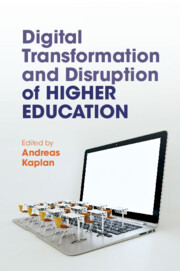Book contents
- Digital Transformation and Disruption of Higher Education
- Digital Transformation and Disruption of Higher Education
- Copyright page
- Contents
- Figures
- Tables
- Contributors
- Preface
- Chapter 1 Nothing Is Constant Except Change
- Part I (R)evolution of the Higher Education Sector
- Part II Changes in Teaching Formats
- Part III Changes in Teaching Content
- Part IV Networking and Social Activities
- Part V Certification and Diplomas
- Chapter 19 Shared Learning in Higher Education
- Chapter 20 Degrees of Disruption
- Chapter 21 Born-Digital Universities
- Chapter 22 Personalisation of Higher Education
- Part VI Careers and Professionalisation
- Part VII Futuristic and Ultramodern Higher Education
- Part VIII Higher Education in Motion
- Editor’s Biography
- Index
- References
Chapter 21 - Born-Digital Universities
Facing the New Competitive Landscape
from Part V - Certification and Diplomas
Published online by Cambridge University Press: 09 June 2022
- Digital Transformation and Disruption of Higher Education
- Digital Transformation and Disruption of Higher Education
- Copyright page
- Contents
- Figures
- Tables
- Contributors
- Preface
- Chapter 1 Nothing Is Constant Except Change
- Part I (R)evolution of the Higher Education Sector
- Part II Changes in Teaching Formats
- Part III Changes in Teaching Content
- Part IV Networking and Social Activities
- Part V Certification and Diplomas
- Chapter 19 Shared Learning in Higher Education
- Chapter 20 Degrees of Disruption
- Chapter 21 Born-Digital Universities
- Chapter 22 Personalisation of Higher Education
- Part VI Careers and Professionalisation
- Part VII Futuristic and Ultramodern Higher Education
- Part VIII Higher Education in Motion
- Editor’s Biography
- Index
- References
Summary
HEIs are nowadays subject to different disrupting events of a varying and transformative nature. Aside from the emergence of EdTechs, the COVID-19 pandemic has brought about the forced digitalization of most traditional higher education institutions (HEIs). In this context, a born-digital university is subject to the increasing dual pressure of traditional universities shifting their learning offers and competition from the new emerging EdTech players. This chapter provides an analysis of the competitive situation of HEIs and the envisaged business model changes required for a born-digital university to tackle this increasing competitive challenge in a context of ongoing digital transformation. It adopts a business approach for higher education, placing the student (as the main client) at the centre of the analysis. The starting point is the identification of the dimensions of student preferences in their choice of higher education provider with a view to analysing the position of the main types of competitors in higher education -traditional, face-to-face universities, and EdTechs- and to ultimately propose a matrix of required business model changes for a born-digital university.
Keywords
- Type
- Chapter
- Information
- Digital Transformation and Disruption of Higher Education , pp. 269 - 288Publisher: Cambridge University PressPrint publication year: 2022
References
- 3
- Cited by



